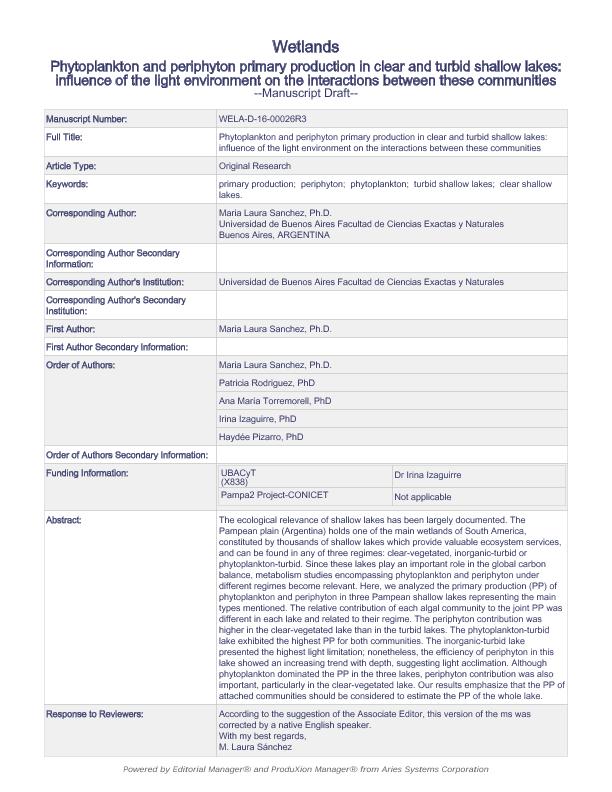Mostrar el registro sencillo del ítem
dc.contributor.author
Sánchez, María Laura

dc.contributor.author
Rodriguez, Patricia Laura

dc.contributor.author
Torremorell, Ana María

dc.contributor.author
Izaguirre, Irina

dc.contributor.author
Pizarro, Haydee Norma

dc.date.available
2018-03-27T18:32:03Z
dc.date.issued
2017-02
dc.identifier.citation
Sánchez, María Laura; Rodriguez, Patricia Laura; Torremorell, Ana María; Izaguirre, Irina; Pizarro, Haydee Norma; Phytoplankton and Periphyton Primary Production in Clear and Turbid Shallow Lakes: Influence of the Light Environment on the Interactions between these Communities; Springer; Wetlands; 37; 1; 2-2017; 67-77
dc.identifier.issn
0277-5212
dc.identifier.uri
http://hdl.handle.net/11336/40187
dc.description.abstract
The ecological relevance of shallow lakes has been largely documented. The Pampean plain (Argentina) holds one of the main wetlands of South America, constituted by thousands of shallow lakes which provide valuable ecosystem services, and can be found in any of three regimes: clear-vegetated, inorganic-turbid or phytoplankton-turbid. Since these lakes play an important role in the global carbon balance, metabolism studies encompassing phytoplankton and periphyton under different regimes become relevant. Here, we analyzed the primary production (PP) of phytoplankton and periphyton in three Pampean shallow lakes representing the main types mentioned. The relative contribution of each algal community to the joint PP was different in each lake and related to their regime. The periphyton contribution was higher in the clear-vegetated lake than in the turbid lakes. The phytoplankton-turbid lake exhibited the highest PP for both communities. The inorganic-turbid lake presented the highest light limitation; nonetheless, the efficiency of periphyton in this lake showed an increasing trend with depth, suggesting light acclimation. Although phytoplankton dominated the PP in the three lakes, periphyton contribution was also important, particularly in the clear-vegetated lake. Our results emphasize that the PP of attached communities should be considered to estimate the PP of the whole lake.
dc.format
application/pdf
dc.language.iso
eng
dc.publisher
Springer

dc.rights
info:eu-repo/semantics/openAccess
dc.rights.uri
https://creativecommons.org/licenses/by-nc-sa/2.5/ar/
dc.subject
Clear Shallow Lakes
dc.subject
Periphyton
dc.subject
Phytoplankton
dc.subject
Primary Production
dc.subject
Turbid Shallow Lakes
dc.subject.classification
Ecología

dc.subject.classification
Ciencias Biológicas

dc.subject.classification
CIENCIAS NATURALES Y EXACTAS

dc.title
Phytoplankton and Periphyton Primary Production in Clear and Turbid Shallow Lakes: Influence of the Light Environment on the Interactions between these Communities
dc.type
info:eu-repo/semantics/article
dc.type
info:ar-repo/semantics/artículo
dc.type
info:eu-repo/semantics/publishedVersion
dc.date.updated
2018-03-27T15:16:37Z
dc.journal.volume
37
dc.journal.number
1
dc.journal.pagination
67-77
dc.journal.pais
Alemania

dc.journal.ciudad
Berlin
dc.description.fil
Fil: Sánchez, María Laura. Consejo Nacional de Investigaciones Científicas y Técnicas. Oficina de Coordinación Administrativa Ciudad Universitaria. Instituto de Ecología, Genética y Evolución de Buenos Aires. Universidad de Buenos Aires. Facultad de Ciencias Exactas y Naturales. Instituto de Ecología, Genética y Evolución de Buenos Aires; Argentina
dc.description.fil
Fil: Rodriguez, Patricia Laura. Consejo Nacional de Investigaciones Científicas y Técnicas. Centro Austral de Investigaciones Científicas; Argentina
dc.description.fil
Fil: Torremorell, Ana María. Universidad Nacional de Luján. Departamento de Ciencias Básicas; Argentina. Consejo Nacional de Investigaciones Científicas y Técnicas; Argentina
dc.description.fil
Fil: Izaguirre, Irina. Consejo Nacional de Investigaciones Científicas y Técnicas. Oficina de Coordinación Administrativa Ciudad Universitaria. Instituto de Ecología, Genética y Evolución de Buenos Aires. Universidad de Buenos Aires. Facultad de Ciencias Exactas y Naturales. Instituto de Ecología, Genética y Evolución de Buenos Aires; Argentina
dc.description.fil
Fil: Pizarro, Haydee Norma. Consejo Nacional de Investigaciones Científicas y Técnicas. Oficina de Coordinación Administrativa Ciudad Universitaria. Instituto de Ecología, Genética y Evolución de Buenos Aires. Universidad de Buenos Aires. Facultad de Ciencias Exactas y Naturales. Instituto de Ecología, Genética y Evolución de Buenos Aires; Argentina
dc.journal.title
Wetlands

dc.relation.alternativeid
info:eu-repo/semantics/altIdentifier/doi/http://dx.doi.org/10.1007/s13157-016-0840-x
dc.relation.alternativeid
info:eu-repo/semantics/altIdentifier/url/https://link.springer.com/article/10.1007%2Fs13157-016-0840-x
Archivos asociados
